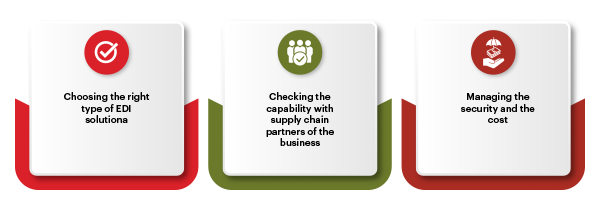Electronic Data Interchange (EDI) is the intercompany communication of business documents in a standard format. In other words, EDI is a standard electronic form that replaces paper-based documents, such as purchase orders and old invoices. Automating these paper-based transactions helps with time-saving, and reduces the errors caused by manual processing. EDI transactions move the information directly from one computer application to another; therefore, enabling quick data sharing with the minimal use of paper or other methods.
With their vast benefits, many businesses want to implement EDI to improve their supply chain management. Industries like Manufacturing, Automotive, Pharma, and Metal Fabrication are already using EDI, making a significant profit with proper data handling.
However, EDI proves to be effective only if the implementation is done right, which requires some planning, such as: –

Motherson Information Technologies Spain S.L.U. helps businesses utilise data, analytics, IoT, and other cloud-based applications through which they can transform their approach to compete in the fourth industrial revolution. The EDI experts at Motherson Technology services first understand the business needs, following which they suggest the most appropriate solution that may help achieve the business goals.
Primary Challenges in EDI Implementation
Even with proper planning and an effective strategy in place, many businesses make common mistakes which affect the implementation of EDI
 Underestimating The Supply Chain Complexity
Underestimating The Supply Chain ComplexityEDI is one of the best ways to overcome the complexity and improve supply chain management, which is why it is used by several businesses at present.However, before implementing EDI, you need to check the supply chain of your business. This implies that the solution has to be aligned with the supply chain requirements. In the current dynamic business market, the supply chains have become more significant, resulting in a benefit and a challenge for EDI asthere is a chance that the EDI system will not connect with the new stakeholders and the new supply chain.
Solution:
Deploy the EDI wisely in your system with the help of an experienced EDI integration partner as they may help you manage the supply chain complexity. Also ensure that the system you are using will accommodate the different transmission protocols.
- Choosing the Wrong EDI
Several types of EDI are available, with different approaches in information exchange and specific pros and cons. Hence, choosing the right EDI is quite a complex and vital decision for your business. Below are the EDI types:
 Direct EDI
Direct EDI EDI via VAN
EDI via VAN Web EDI
Web EDI
Solution:
Recent EDI developments are mainly focused on simplifying the management under supply chain methods. For this, Web EDI is one of the best EDI types implemented for long-term execution.
 Incomplete Or Corrupted Data
Incomplete Or Corrupted Data
With new EDI implementation, your existing data might undego a test, which will require a system which may help simplify the creation of data over time. A few EDI formats are difficult for humans to understand, due to which it is tricky to analyse, catch, and fix errors and require unique skill sets. Even manual error detection is time-consuming and costly and can ultimately result in transaction errors.
Solution:
The alarming data or the data with errors originate at the order level. Using EDI for this data is nothing but a method to remove human errors, but the data has to be correct. For checking and improving your data, the best place is your ERP or your trading partners.
 Forgetting About Security
Forgetting About Security
With EDI in place, you can contact your supply chain partners, but by doing this, you expose your system’s internal elements with those partners. Partnership with international clients can further complicate things involving legal matters, privacy, and protection rules.
Solution:
It is important to note that the security issues caused by EDI are primarily physiological. You need to make sure that the encrypted transfer protocols are used for information sharing, especially if you manage sensitive data, like health care information.
In a Nutshell
EDI is a great way to automate the exchange of vital information with your partners, which cuts down on manual processing and helps prevent order errors while giving you real-time visibility into the supply chain of your business. However, you need to have a clear set of goals and deep knowledge of your supply chain relationships for an effective EDI implementation.
Addressing all these EDI challenges require the right tools and processes. While EDI is here to stay, you need to ramp up your business process efficiency and attain maximum supply chain performance with our EDI solutions.
We will be happy to help you find the right tool for your business and prevent these common EDI issues. To learn more how can we assist you, reach out to us by visiting our website.
About the Author:

Roger comes with over 15 years of international robust business/solution management experience, particularly in influencing and leading business growth and Agile digital transformation across the company. His ability to work in a rapidly changing and highly demanding work environment sets him apart from the rest.








